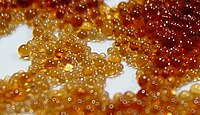
Efficient secretion of three fungal laccases from Saccharomyces cerevisiae and their potential for decolorization of textile industry effluent—A comparative study
Sign Up to like & getrecommendations! Published in 2018 at "Biotechnology Progress"
DOI: 10.1002/btpr.2559
Abstract: Laccases are enzymes with a broad range of biotechnological applications and have, for example, the ability to oxidize many xenobiotics including synthetic dyes. In order to obtain an efficient laccase for the decolorization of dyes… read more here.
Keywords: three fungal; saccharomyces cerevisiae; textile industry; industry ... See more keywords

Azo dyes decolorization under high alkalinity and salinity conditions by Halomonas sp. in batch and packed bed reactor
Sign Up to like & getrecommendations! Published in 2019 at "Extremophiles"
DOI: 10.1007/s00792-019-01149-w
Abstract: Biodecolorization and biodegradation of azo dyes are a challenge due to their recalcitrance and the characteristics of textile effluents. This study presents the use of Halomonas sp. in the decolorization of azo dyes Reactive Black… read more here.
Keywords: high alkalinity; azo dyes; salinity; alkalinity salinity ... See more keywords

Study on the optimization of the decolorization of orange essential oil
Sign Up to like & getrecommendations! Published in 2018 at "Food Science and Biotechnology"
DOI: 10.1007/s10068-018-0354-9
Abstract: The effects of diatomite, activated clay and acticarbon on the decolorization of orange essential oil were investigated. Single factor and orthogonal tests were performed to determine the optimum discoloring conditions. The results showed that the… read more here.
Keywords: essential oil; orange essential; activated clay; decolorization ... See more keywords

Parametric ratio-based method for efficient contrast-preserving decolorization
Sign Up to like & getrecommendations! Published in 2017 at "Multimedia Tools and Applications"
DOI: 10.1007/s11042-017-5143-6
Abstract: Decolorization is a fundamental technology indispensable for image processing, digital printing, and photograph rendering, while it suffers from information loss. This paper presents a novel parametric ratio-based method for efficient contrast-preserving decolorization (PrDecolor). For better… read more here.
Keywords: contrast; ratio based; based method; parametric ratio ... See more keywords

Kinetic study of methyl orange decolorization by the Fenton process based on fractional factorial design
Sign Up to like & getrecommendations! Published in 2020 at "Reaction Kinetics, Mechanisms and Catalysis"
DOI: 10.1007/s11144-020-01803-x
Abstract: In this study, a correlation of kinetic parameters was established for the decolorization of a methyl orange (MO) azo dye by Fenton oxidation. The experiments were carried out in a batch reactor at room temperature… read more here.
Keywords: fractional factorial; factorial design; study; methyl orange ... See more keywords

Performances of Pichia kudriavzevii in decolorization, biodegradation, and detoxification of C.I. Basic Blue 41 under optimized cultural conditions
Sign Up to like & getrecommendations! Published in 2018 at "Environmental Science and Pollution Research"
DOI: 10.1007/s11356-018-3651-1
Abstract: The aim of this study was to evaluate the performances of Pichia kudriavzevii CR-Y103 yeast strain for the decolorization, biodegradation, and detoxification of cationic dye C.I. Basic Blue 41, a toxic compound to aquatic life… read more here.
Keywords: biodegradation detoxification; decolorization biodegradation; pichia kudriavzevii; performances pichia ... See more keywords

Exploration of the key functional strains from an azo dye degradation microbial community by DGGE and high-throughput sequencing technology
Sign Up to like & getrecommendations! Published in 2019 at "Environmental Science and Pollution Research"
DOI: 10.1007/s11356-019-05781-z
Abstract: This study investigated a previously developed thermophilic microbial community with the ability to effectively degrade azo dyes. To identify the key microbes of this microbial community, a dilution-to-extinction approach was combined with polymerase chain reaction-denaturing… read more here.
Keywords: azo dye; degradation; microbial community; community ... See more keywords

Melt-spun modified poly (styrene-co-butyl acrylate) fiber as a carrier to support manganese oxide and its application in dye wastewater decolorization
Sign Up to like & getrecommendations! Published in 2020 at "Environmental Science and Pollution Research"
DOI: 10.1007/s11356-020-09105-4
Abstract: Polymer fiber, a kind of versatile material, has been widely used in many fields. However, emerging applications still urge us to develop some new kinds of fibers. Advanced oxidation processes (AOPs) have created a promising… read more here.
Keywords: manganese oxide; melt spun; fiber; wastewater ... See more keywords

Solar photocatalytic decolorization of synthetic dye solution using pilot scale slurry type falling film reactor
Sign Up to like & getrecommendations! Published in 2017 at "Korean Journal of Chemical Engineering"
DOI: 10.1007/s11814-017-0204-0
Abstract: Ag deposited TiO2 was prepared by simple chemical reduction method and its photocatalytic efficiency was evaluated for the decolorization of methylene blue dye using pilot scale slurry type falling film reactors (FFR) under sunlight. The… read more here.
Keywords: using pilot; pilot scale; deposited tio2; dye ... See more keywords

Characteristics of White-rot Fungus Phlebia brevispora TMIC33929 and Its Growth-Promoting Bacterium Enterobacter sp. TN3W-14 in the Decolorization of Dye-Contaminated Water
Sign Up to like & getrecommendations! Published in 2019 at "Applied Biochemistry and Biotechnology"
DOI: 10.1007/s12010-019-03062-6
Abstract: The dye decolorization potential of the white-rot fungus Phlebia brevispora TMIC33929 when grown alone or in coculture with its growth-promoting bacterium Enterobacter sp. TN3W-14 was evaluated in low nitrogen liquid medium at different pHs. Axenic… read more here.
Keywords: rot fungus; fungus; dye; white rot ... See more keywords

Hydrochar-derived activated carbon from sugar cane bagasse employing hydrothermal carbonization and steam activation for syrup decolorization
Sign Up to like & getrecommendations! Published in 2020 at "Biomass Conversion and Biorefinery"
DOI: 10.1007/s13399-020-00635-y
Abstract: Activated carbon (AC) was produced from sugarcane bagasse using hydrothermal carbonization (HTC) and steam activation for syrup decolorization. The HTC temperature was 180–240 °C over 30–90 min of holding time and the steam activation temperature was 700–900 °C… read more here.
Keywords: steam activation; syrup decolorization; decolorization;